We’ve been sending a weekly “Six Feet in Solidarity” email on Thursdays to stay connected and continue serving up resources to build your water knowledge around different topics while social distancing. We’ve been pulling from our library of publications, news stories, webinars, videos, radio programs, and more, and also sharing key resources produced by others in the water community.
Thus far we’ve sent emails focused on land use and water, stream management plans in Colorado, environmental justice and equity in the water sector, water reuse, alternatives to ag transfers or ATMs, forest and watershed health, and climate change and its projected impacts on Western water.
After eight weeks, as Colorado’s stay-at-home order is replaced with its new safer at home, we bring you the last in our Six Feet in Solidarity series. This week is Drinking Water Week, which recognizes the vital role tap water plays in daily life, the infrastructure that is required to carry it to and from homes and businesses, and the important behind-the-scenes work of water professionals. To celebrate, we’re focusing our final solidarity email on drinking water. Read on to learn more. Continue to be well and don’t stop social distancing!
Safe and Available Drinking Water Supplies

Adobe Stock
Across the country, drinking water crises have been making the news. During the pandemic we’ve seen communities battling water shutoffs. Even before COVID-19, over the past five years the spotlight of national news shone on water quality challenges like lead poisoning, harmful algal blooms, and communities facing contamination from a class of manmade chemicals known as per- and poly-fluoroalkyl substances, or PFAS. All raise concerns about whether the nation’s current drinking water regulations do enough to protect us.
Growing awareness of the unregulated contaminants that might be transmitted through our taps has bred an atmosphere of distrust, leading more of the 286 million Americans who get their water from a community water system to filter or avoid tap water, buying bottled drinking water instead. While such precautions are necessary in times of crisis, water providers stress that, overall, our regulated municipal drinking water supplies are very safe.
The system isn’t perfect. While advances in water management and sanitation have substantially reduced waterborne disease across the nation, outbreaks still occur, often from unregulated systems. In 2011–2012, for example, 32 drinking water-associated outbreaks were reported to the Centers for Disease Control and Prevention’s (CDC) Waterborne Disease and Outbreak Surveillance System, though they weren’t all associated with public water systems. Nevertheless, CDC concurs that the United States has one of the safest public drinking water supplies in the world. Read more about it in “Setting the Standard” from the fall 2016 issue of Headwaters magazine.
How does the Safe Drinking Water Act keep drinking water safe?
From WEco’s Citizen’s Guide to Colorado Water Quality Protection:
The federal Safe Drinking Water Act was adopted by Congress in 1974 to protect public health by regulating the quality of the nation’s public drinking water supply. The Safe Drinking Water Act complements the Clean Water Act by protecting both surface and groundwater quality used for drinking and guarding consumer health by establishing standards for the quality of water delivered to our taps and faucets.
Major Elements of the Safe Drinking Water Act:
• EPA national drinking water standards apply to all public water systems, defined as systems with at least 15 service connections or which provide drinking water to an average of at least 25 people daily for at least 60 days out of the year. These systems are further classified as either “community” or “non-community” depending upon whether they serve residents year-round.
• Public water systems must conduct regular monitoring and notify the public of monitoring results, including any violations of drinking water standards.
• Community systems must provide Consumer Confidence Reports to the public, highlighting the results of their monitoring.
• Water system operators must be certified to assure they have adequate education and experience for the operation of public water systems or states will lose substantial federal funding.
• Every state must develop a source water assessment program to identify potential contamination threats to public water supplies.
Not all Coloradans have access to tap water
From “Plumbing Poverty” in the Spring 2020 issue of Headwaters magazine.

Courtesy Shiloh Deitz
Some 1.5 million Americans—that’s 463,649 households, or 0.39 percent of all households—live with incomplete plumbing, defined as missing at least one of either hot and cold running water, a flush toilet, or an indoor bathtub or shower.
A study published in August 2019 in the Annals of the American Association of Geographers gave an accounting of the scale of “plumbing poverty,” showing a clear racial breakdown: American Indian and Alaska Native households were 3.7 times more likely to have incomplete plumbing, and both black and Hispanic populations had a greater share of households with incomplete plumbing.
The problem persists around Colorado, especially in rural areas in the southwestern part of the state. A 2007 study in Geoforum also found mountainous areas had spotty plumbing due to “remoteness, construction difficulties, occupancy of seasonal housing on a year-round basis and minimal enforcement of plumbing codes.” Read the full story.
More Resources from WEco on Drinking Water
Headwaters magazine: Renewing Trust in the Safety of Public Water
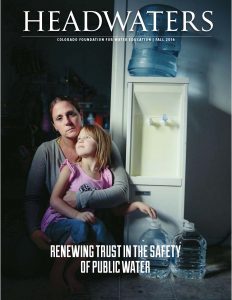 This issue introduces the law and policy governing safe drinking water, then takes a close look at how public health concerns related to as-yet-unregulated contaminants are monitored and evaluated. Read the fall 2016 issue.
This issue introduces the law and policy governing safe drinking water, then takes a close look at how public health concerns related to as-yet-unregulated contaminants are monitored and evaluated. Read the fall 2016 issue.
Fresh Water News: Colorado health officials, citing rise of “forever chemicals” in water, vow to increase oversight
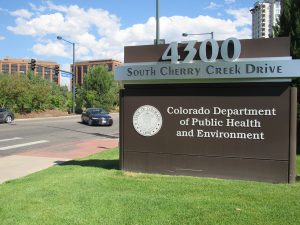
Colorado public health officials are set to begin regulating one of the most controversial sets of cancer-linked chemicals in water supplies, citing increasing evidence of the compounds around the state. Read the story.
Fresh Water News: Denver Water asks EPA for rare exemption from Safe Drinking Water Act

Denver Water is asking the U.S. Environmental Protection Agency for a rare exemption to the Safe Drinking Water Act, the latest move in the utility’s long-running legal dispute with state health officials over how best to keep lead out of its customers’ tap water. Read the story.
Connecting the Drops: Monitoring for lead in schools
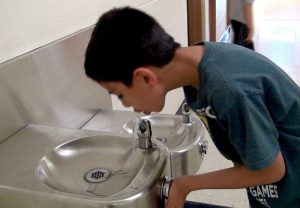 When cost-cutting in Flint, Michigan raised lead contamination in local drinking water, the nation became aware that water can corrode pipes and carry dangerous amounts of lead. The failures in Flint may result in stronger rules nationwide for monitoring home drinking water but schools are not part of these public tests. That’s why Colorado legislators proposed a bill to help more Colorado schools pay for testing lead in their drinking water. Meanwhile, some Colorado schools have taken on the cost themselves. Listen to the story, from 2017, produced through Connecting the Drops, our partnership with Rocky Mountain Community Radio stations.
When cost-cutting in Flint, Michigan raised lead contamination in local drinking water, the nation became aware that water can corrode pipes and carry dangerous amounts of lead. The failures in Flint may result in stronger rules nationwide for monitoring home drinking water but schools are not part of these public tests. That’s why Colorado legislators proposed a bill to help more Colorado schools pay for testing lead in their drinking water. Meanwhile, some Colorado schools have taken on the cost themselves. Listen to the story, from 2017, produced through Connecting the Drops, our partnership with Rocky Mountain Community Radio stations.
Citizen’s Guide to Colorado Water Quality Protection
This guide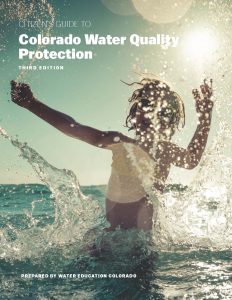 provides an overview of water quality issues important to Colorado. It also tackles the complex water quality protection framework, including laws and regulations, on a national, state, and local level, which helps ensure that we protect, restore and maintain the quality of this natural resource.
provides an overview of water quality issues important to Colorado. It also tackles the complex water quality protection framework, including laws and regulations, on a national, state, and local level, which helps ensure that we protect, restore and maintain the quality of this natural resource.
More Resources from Other Organizations
Drinking Water Resources and Homeowner Water Testing from CDPHE
![]() The Colorado Department of Public Health and Environment offers many resources on drinking water including information on regulations, rulemakings, policies and more. Check out their homeowner water testing page to learn how to check and make sure your water is safe.
The Colorado Department of Public Health and Environment offers many resources on drinking water including information on regulations, rulemakings, policies and more. Check out their homeowner water testing page to learn how to check and make sure your water is safe.
Consumer Confidence Reports
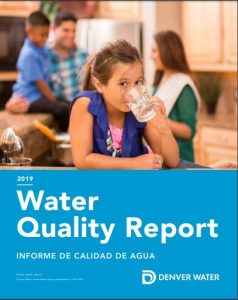 Water providers must sample and test their water, with those samples monitored by the Environmental Protection Agency and the Colorado Department of Public Health and Environment. Those agencies also require water providers to issue an annual report on water quality. You should be able to obtain a consumer confidence report from your water provider or, for those who live in Denver Water’s service area, find their 2019 report here.
Water providers must sample and test their water, with those samples monitored by the Environmental Protection Agency and the Colorado Department of Public Health and Environment. Those agencies also require water providers to issue an annual report on water quality. You should be able to obtain a consumer confidence report from your water provider or, for those who live in Denver Water’s service area, find their 2019 report here.
AWWA Briefing on PFAS
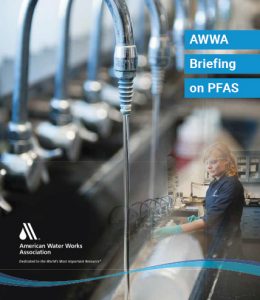 The presence of PFAS compounds in source water and drinking water is of increasing public concern due to their widespread use and environmental persistence. The AWWA Briefing on PFAS provides information and guidance for water professionals challenged to address this emerging contaminant.
The presence of PFAS compounds in source water and drinking water is of increasing public concern due to their widespread use and environmental persistence. The AWWA Briefing on PFAS provides information and guidance for water professionals challenged to address this emerging contaminant.
AWWA Resources on Lead in Drinking Water
Here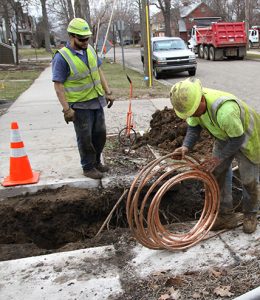 you will find insights on corrosion control and other lead management issues, the latest legislative and regulatory developments, and public outreach tools to help you speak with consumers and other key stakeholders.
you will find insights on corrosion control and other lead management issues, the latest legislative and regulatory developments, and public outreach tools to help you speak with consumers and other key stakeholders.


 Print
Print